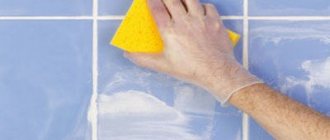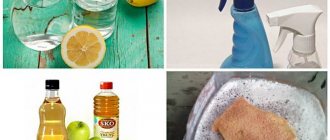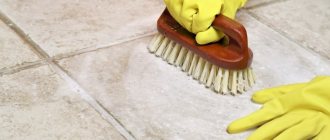Does old grout need to be replaced?
The need to replace old grout may arise for at least several reasons:
- You have decided to change the design somewhat and choose a brighter, or, conversely, less shade for the joints in order to emphasize the originality of the tile. Quite often, this method is practiced in cosmetic repairs without changing ceramics, which allows you to create literally new conditions.
- The reason for replacing the old grout is its deterioration, which occurs due to insufficient quality and imperfection of the material processing technology. For example, porcelain stoneware is obtained by firing it in a kiln at more than 1000 degrees, which cannot be done with grout.
- The work on tiling the walls was carried out poorly, as a result of which the material was damaged and began to have an unsuitable appearance.
- Sometimes it becomes necessary to partially or completely replace the tiles, and then the grout is completely removed.
To seal the seams between the dies with a new fugue or other similar material, it is necessary to remove the old one from it. This is necessary in order to ensure a stronger retention of fresh material.
To understand how to remove old grout from tile joints in a bathroom or kitchen, you should first become familiar with all types of materials that are used to seal joints. They are roughly divided into the following varieties:
- Cement-based is the most inexpensive and common type of joint sealer. It has good water-repellent properties, but without special water-repellent components it cannot be used for bathrooms. It is in this type of grout that mold most often occurs if it was chosen incorrectly and not applied according to technology.
- Epoxy-based is a special type of high-strength decorative materials that perfectly protects tiles and walls from getting wet. It is insoluble in water and has a resinous structure.
- Silicone is a highly effective type of joint sealing material that is used to seal surfaces that are in regular contact with water. They do not form cracks, maintain tightness and provide an attractive appearance.
For each of the listed types of materials, a different product is used to seal the seams between ceramics and porcelain stoneware, because today there is no universal one.
The fact is that they have their own specific properties and have a unique composition, and therefore will interact with different substances in different ways.
For example, silicone is dissolved by vinegar, but cement compositions do not change in any way under its influence.
We also recommend watching - Grouting tiles in the bathroom: types, how to choose and use
Do you think it is worth changing the grout between the seams?
Not really
Types of grout and technology for their removal
Depending on the type of mixture used, the method of removing it may differ, so different tools are needed. Renovator is a multifunctional tool for the household.
The renovator can carefully remove the old grout between the tiles
Cement fugue
Often you have to remove the cement mixture from the seams - it is hygroscopic and absorbs everything that comes into contact with it.
In rooms with high humidity, mold and mildew settle in this composition, which not only worsens the aesthetic perception of the finish, but is also harmful to human health.
To do the job you will need the following tools:
- knife for removing grout from tile joints;
- seam remover;
- foam sponge.
To remove grout from tile joints without much effort, you need to soften it with water or a solvent selected for this purpose.
- Using a foam sponge, all seams are impregnated with a special liquid.
- The joint spacer is used to clean the space between the tiles.
It is important! In the absence of a special tool, the cement composition can be removed using a knife, scraper, screwdriver or simple nail, but in this case the risk of damage to the edges of the tile increases.
Washing tiles after grouting comes down to tedious mechanical work of scraping out the soggy compound from all the cracks. When working without wetting the surface, dust will be generated, so it is recommended to wear safety glasses and a respirator.
Epoxy resin composition
Once cured, the epoxy composition becomes as strong as stone, so it lasts a long time. The need to replace it occurs infrequently, but it causes a lot of trouble.
To remove old grout you will need an epoxy resin solvent. The softened composition is removed from the space between the tiles in the standard way.
It is important! The purchased grout remover can damage the enamel on the front side of the tile. The solvent is applied to a small area of the tile - if it does not react with the enamel, then it can be used for its intended purpose. Experts recommend using a hair dryer to remove epoxy resin
Experts recommend using a hair dryer to remove epoxy resin.
In this case, you can remove the grout between the tiles after thorough heating. Make sure that the leaked resin does not harden on the tile itself when removed.
What to consider when deleting
Removing various mixtures of composition from seams requires a careful approach, just like applying a new fugue to cleaned seams, so that you don’t have to redo it, do the work correctly from the beginning.
Acid or household chemicals must be applied with caution
- Many people can fill cracks with cement, but not everyone can do it beautifully. You can ruin your work if you wash the fugue from the tiles too early, when it has not yet hardened in the joints. The seams are rubbed in the usual way, when leveling them with a sponge, the excess is removed, and the surface remains smeared. You can wipe off the thin layer of grout later.
- It is not easy to remove epoxy grout from tiles if time is lost. The work of filling the joints is carried out on a small area - 1-2 m2, and is cleaned no later than 5 minutes from the moment the composition is applied. The process is complicated by the fact that the epoxy fugue sets quickly and takes a long time to dry, and you can accidentally wash the substance out of the seams. Cleaning of epoxy grout is done with a fiber nozzle and then with a soft sponge soaked in water. To achieve the desired effect, you need to regularly change the water and sponges.
It is important! You can remove dried grout from tiles with acetone, concentrated acetic acid or a solvent (chloroform, tetrahydrofuran, methylene chloride), but they are harmful to human health.
Individual protection means
To safely remove grout and various grouts from the joints between tiles, you must first of all follow safety precautions.
This is an important point, because means for softening hardened compounds are quite caustic and chemically active.
If it comes into contact with the skin, it can cause irritation and discomfort, not to mention allergic symptoms. Therefore, when starting work on removing old mortars and other putties from the joints between tiles, it is necessary to use personal protective equipment. These include:
- Rubber gloves are the main protective accessory that will protect your hands from all kinds of negative reactions from acids and alkalis. Thin medical ones may not be useful when working with some types of drugs.
- A mask or respirator is an especially important accessory if work is performed in a dry, mechanical manner. In this case, a lot of dust is generated, from which you need to protect your respiratory organs.
- Workwear is an element of personal protection that will protect against contamination generated during work. This also includes shoes.
Determine the correct cleaning method
Textured tiles can be easily cleaned from the grout mixture using special chemical solutions.
The choice of method depends only on the composition of the grout, so use the table to determine which method you will use:
| Type of grout | Removal Remedies and Methods |
| Method 1: for cement grout. Removal methods:
| |
| Method 2: for epoxy resin grout. Removal methods:
|
Method for cement grouting
This method is based on the use of highly active acid-containing solutions.
Gel-like, liquid products fill any textured surface, making work easier.
After applying the remover to the textured surface, the active components soften the cement composition.
So, how to clean grout from tiles:
- liquid concentrate (for any tiles);
- powder product (not recommended for porous and marble materials).
The table describes the stages of cleaning tiles from grout:
| Image | Washing steps |
Stage 1. Prepare for work:
| |
Step 2. Apply the solution:
| |
Step 3: Wipe off dirt:
| |
| Step 4. Rinse thoroughly. Use a sponge soaked in water to wash off the remaining remover. |
Traditional methods: 7 recipes
You can use household chemicals available at home. Here is a table showing how you can wash tiles with a textured surface:
| Photo | Application |
| Method 1. Floor tile cleaner. Treat cement stains with any cleaning solution containing acid. Spread the liquid over the stained area. Residues can be removed after 15 minutes with a brush. | |
| Method 2. Limescale remover. This composition can be used to clean floor tiles after renovation. Rub this liquid into the relief patterns with a brush. | |
| Method 3. White spirit solution. You can easily wash porcelain tiles after repairs by dissolving 1 tablespoon of white spirit in a glass of water. Then you need to thoroughly clean the remaining composition from the surface. | |
| Method 4. Glycerin. The gentle substance will not damage the tiles. Make a mixture of 1 part glycerin and 3 water. Price – about 20 rubles. | |
| Method 5. Ammonia solution. To avoid cement stains, use a solution of ammonia (a tablespoon per liter of water). | |
| Method 6. Citric acid. Using citric acid, you can easily wash off both cement grout and limescale from the tiles:
| |
| Method 7. Soda and vinegar. It is possible to wash the tiles after repair with a homemade cleaning paste. The acid will soften the cement, and the soda will clean the relief surface:
|
Method for epoxy resins
In order not to stain the relief tile with resin, you need to seal it with film and tape.
Epoxy resin makes the composition invulnerable to acids or alkalis, and hardens within a day. Therefore, the answer to the question of how to clean tiles in the bathroom is a clear answer - only with strong special reagents (cleaners).
Cleaning liquids will soften the hardened grout.
How to remove epoxy resin:
| Image | Instructions |
Step 1. Prepare for work:
| |
| Step 2: Cover the seams with masking tape. A double layer of tape will not allow solvent to enter the joint filled with grout. | |
| Step 3: Apply solvent to stains and scrape them off. You can wash the tiles after repair from grout 10 minutes after applying the softening compound. Work the affected areas with a wire brush or scraper. | |
| Step 4. Wash the tiles in the bathroom from any remaining solution. Soak a sponge in detergent and rinse the cleaned raised area thoroughly. |
Softening compounds
Depending on the technology and materials, there are 2 ways to remove grout from the seams of wall or floor coverings:
- Mechanical is an effective method, but very labor-intensive. To remove grout from the joints between tiles, you will need the appropriate tools. This can be a spatula, a scraper, and in some situations a screwdriver helps. But for high-quality and quick removal of the composition, it is better to use a universal tool with attachments: various spatulas, scrapers and other devices. For ease of work, it is recommended to use a vacuum cleaner.
- Chemical is a reliable method for removing grout joints. They are various liquid or semi-liquid, gel-like compositions, which, as a result of a certain chemical reaction, literally dissolve the fugue, soften it, making it elastic and pliable, then it still needs to be removed mechanically. Therefore, this method is also called combined.
If everything is clear with mechanical procedures, then with chemical procedures the situation is a little different. Such materials, due to their active formula, literally dissolve solid mixtures, forming a soft or liquid mass, which is then quite easily removed from the seam mechanically.
It is important to know! If epoxy resins were used to seal the seams between the tiles, then it is better to entrust the work of removing it to experienced craftsmen, since after drying such materials become hard as stone.
If you nevertheless decide to use mechanical methods for removing grout from the seams of tiles or porcelain stoneware, then there are several types of reagents on sale that effectively affect the grout:
- Products for cement grout – Valo Clean . A highly effective solvent that has a significant effect on various types of cement compositions. It is usually used if mold has formed in the seams and fungus has developed. The composition has strong antiseptic and disinfecting properties.
- Keranet – special types of acid-based chemicals that are used to dissolve fugue mainly on ceramic tiles. The acid is a dry powder with a high concentration of the active substance, and is also sold in the form of a liquid solution prepared on the basis of organic acid.
- Litostrip is a special active substance that is used to effectively remove epoxy-based grout.
They provide a high degree of purification and quality removal of the mixture from the joint. The principle of working with the solution is as follows: the composition is stirred and applied to the seams, after leaving for a certain time it is removed mechanically using a spatula. It is important to know! When deciding to purchase an organic acid to remove grout, keep in mind that it is not recommended for marble, natural stone, or glazed ceramics. The substance may cause damage to decorative coatings.
How to clean tiles after grout repair?
To avoid problems with cleaning grout from the surface of ceramic tiles, you should remember that such contaminants are most easily and quickly removed during the repair process, before the building mixture has had time to harden.
After tiling a small area, you should check how well the mortar has set and begin removing dirty drops and marks on the ceramic surface. To check the condition of the grout:
- Lightly dampen the seam with a damp cloth.
- Observe the behavior of the material.
Important! Evaluate the result based on the following criteria:
- If the grout begins to swell and extend beyond the boundaries of the seam, then this behavior of the building material indicates insufficient hardening and a low degree of adhesion.
- If you don’t notice any changes after soaking, then everything is fine and you can start cleaning the surface from any remaining building material.
Grout removal technologies
You can clean the tiles from grout after repair in two stages:
- Dry cleaning. This procedure is carried out after laying a small section of tile by wiping the surfaces using a special grater. The tool is held at right angles to the coating.
Important! It is recommended to carry out cleaning movements diagonally to the surface of the seams. This direction will help you avoid damage to grout that has not hardened completely.
- Washing the surface. Wet cleaning of the tile surface should begin after the grout has partially hardened. For this procedure, it is recommended to use a piece of foam rubber, which is generously moistened with water.
Important! Remove any remaining dirt from the glossy surface with a hard cloth, felt or burlap. This procedure will avoid streaks on the smooth surface of the tiles.
Chemical composition
Each product for removing old grout from joints on a ceramic or porcelain tile has its own properties, which is determined by the components it contains.
It is important to perform all operations correctly so that no traces remain on the surface of the tile after the reagents themselves.
Therefore, we will consider the properties and composition of preparations for each type of fugue.
For cement-based grouts
For cement-based grouts, compositions are used based on organic acids. They are similar in their properties to hydrochloric or sulfuric acid, but are not dangerous to humans, since when interacting with other substances they do not emit acrid smoke or various fumes.
When working with them, you should be very careful not to get the composition on your hands, as it can cause allergic reactions.
Suitable not only for grouts, but also for concrete and various adhesive mixtures. Before use, the contents of the bucket must be mixed with water and shaken thoroughly until smooth. Clutoclean and Litoclean Plus products have these properties.
Interesting to know! Do you want to save money, but grout removers are quite expensive? You can use the folk method using citric acid, vinegar and laundry soap. All this is mixed with water and applied to the surface that needs to be cleaned.
For epoxy compounds
Epoxy-based grouts are highly reliable and durable, which is good if the repair is done forever and bad when you want to change it. This is due to the natural physical properties of the resin, which hardens and becomes like stone.
The average service life of such joint sealing is usually at least 30 years.
To combat stains based on epoxy resins, it is recommended to use the product Litocol, you can also use the substance in the form of a gel. In fact, this drug is universal, as it is able to successfully dissolve fat, oil, foam, ink and wax.
The product is universal, as it can be used to clean grout from all types of tiles and is diluted to the required consistency with water. It is a concentrated alkaline solution.
For silicone sealants
To remove silicone grout from joints, it is necessary to use special potent preparations. There are many varieties of them on sale, all of them work approximately the same.
The most common effective actions include:
- Penosil Silicone R;
- Silicon-Entferner;
- Dow Corning OS-2;
- Antisil;
- Penta-840;
- Forch R551;
- R507.
All compositions for combating old silicone in the seams between tiles and in any other places contain acids. It is not without reason that it is present in many varieties, as evidenced by the characteristic smell.
It is important to know ! If the seams were filled with silicone sealant many years ago, then it can probably be dissolved with white spirit. This is an effective remedy, no doubt, but not for modern brands of silicones, because recent developments have become even more reliable and resistant to various chemicals. Only the materials described above can handle them.
How to care for tiles
In order for the coating to last for a long time, you need to know how to properly care for tiles.
For glossy structures, strong acid-based detergents should not be used. This may damage the gaps and seams between the products.
It is best to purchase special products for tiles, ceramic tiles and porcelain tiles.
Do not use metal brushes or abrasive powders because they will severely scratch the surface of the coating. This is especially noticeable on glossy ceramic tiles.
The Best Tile Cleaners
To ensure that the tiles retain their attractive appearance for a long time and do not fade, it is better to use specialized mild detergents:
- Mister Muscle. Eliminates plaque, rust, removes stains from the surface of tiles and gives it shine. It is necessary to apply the liquid to the dirt, wait 3-5 minutes and walk again with a damp sponge. It copes well with old, stubborn stains and does not run off vertical surfaces. In this case, there is no need to scrape and rub the plaque with a washcloth. The detergent perfectly removes even formed mold from the grout.
- Frosch. Suitable for most types of tiles. Effectively removes dirt, grease, stains and plaque from ceramic tiles. Frosch is harmless to the body. The product neutralizes unpleasant odors and kills germs. To clean the tiles from dirt, dilute 2 caps of detergent in 5 liters of water and clean the surface. Not intended for use in its pure form.
- Cif Anti-plaque. Removes accumulated dirt thanks to a unique water- and dirt-repellent formula. In a matter of seconds it will remove limescale and soap stains from the surface of the tile. SIF should be applied evenly to the dirt, wait 5 minutes and rinse with clean water.
- Domestos. Effectively eliminates fungus, whitens grout joints between tiles and disinfects. Directions for use: Dilute 2 caps of gel in a five-liter bucket of water and remove dirt with a sponge or soft-bristled brush. Then rinse the surface with water and wipe dry.
- San-klin (Santik). Liquid for removing limescale, rust and other contaminants from tiles. It must be applied to the surface for 5-10 minutes and then remove any remaining dirt.
You can also use the following aids to clean tiles:
- Bleaching powder. Dilute the powder with clean water. Pour the solution into a spray bottle and spray it onto the desired surface. Then leave for five minutes and rinse with plenty of clean water. Let the ceramics dry or wipe the surface with a dry cloth. Chlorine solution kills germs and gets rid of mold.
- Melamine sponge. Easily wipes off minor stains, removes limescale and does not spoil the appearance of the cladding. You just need to wet the sponge and rub away the dirt.
- Steam cleaner. A gentle alternative to aggressive cleaning liquids. Steam cleans the tile surface no worse than chemicals. And at the same time it does not have any mechanical effect. Steam supplied under high pressure dilutes grease stains on the tiles and disinfects the surface being cleaned, killing germs. The steam cleaner is excellent at removing mold and limescale in the bathroom. It easily removes even greasy stains in the kitchen.
To prevent ceramics from fading and scratches appearing on it during use, you need to treat it with a special varnish. A durable protective coating is created, the color does not change for many years, and caring for the tile surface is greatly simplified because almost no dirt accumulates on the varnish coating.
With proper cleaning and good timely care, ceramic tiles will last for many years.
Treating cracks with steam and covering with a masking compound
In addition to chemical and mechanical methods of removing sealant from the joint between tiles, you can use hot steam. The fact is that silicone usually withstands temperatures up to 90 degrees, and steam is much hotter, so it has a destructive effect on sealants and effectively removes it.
In such a situation, you need to work as follows:
- Direct the steam stream to the area to be treated and hold for a few seconds. During this time, the sealant literally peels off from the base.
- Afterwards, using a hard-bristled brush and water, the material is removed from the seam with vigorous movements. Typically, exposure to a concentrated jet of steam occurs simultaneously with mechanical removal of the sealant, that is, special brushes are used.
If the place needs to be restored without removing the old grout, then cover it with a special pencil with a waterproof filler or cover it with a water-based composition.
Rules for working with cleaning products
Most grease removers - both homemade and store-bought - can cause an allergic reaction, poisoning, or, if actively inhaled, a burn to the lungs.
To work with household and folk chemicals, you must strictly follow the safety rules:
- Cover your clothes with a long, thick apron;
- be sure to wear rubber gloves;
- do not lower your head low to the surface to be cleaned so that the acid vapors do not burn your throat and lungs;
- read the instructions for the purchased product;
- remove all food products from the table and kitchen counter;
- Make sure that children and pets do not have access to the kitchen.
After cleaning, wash your hands, face and neck very thoroughly, it is even better to take a shower with shampoo and soap. Rinse the gloves thoroughly, wash the apron in the machine. After cleaning the kitchen, it is better to immediately throw all clothes into the washing machine.
Before work, it also makes sense to make sure that the window in the kitchen is open, and if possible, you should also turn on the hood. You should not inhale fumes from household chemicals or vinegar - they can cause a real burn to the larynx and mucous membranes.
After washing the tiles, the window should be left open for at least 30 minutes in winter, and for two hours in summer, so that all the toxic fumes are blown outside.
Application of chemical reagents
Don't know how to remove old grout from ceramic tile joints? An effective method is chemicals. For each type of fugue, you need to choose your own cleaner.
Let's look at an example of using cement removers using Sopro ESE 548 solvent:
- First of all, you need to apply the composition and wait for at least 20 minutes.
- After the joint filler has softened, mechanical removal begins using a scraper or jointer.
- The separated fugue residues are removed with a wet rag or sponge.
After the surface has completely dried, you can begin filling the new composition.
If the seams were filled with a thick layer of silicone sealant, then a chemical agent, for example, Penta-840, is applied twice, after removing the top layer or most of it from the joint.
Applying a new fugue
Once the old grout has been removed, you can begin applying a new grout. To solve this problem you will need the following tools:
- Fugue and the container in which it will be diluted.
- If the amount of work is large, then to stir the fugue you will need a drill with a mixer.
- A rubber spatula or float with which the grout will be applied.
- Water. To mix the solution, you can use a special liquid, which can be found in a hardware store.
Particular attention is paid to the choice of grout. To give it the desired color, you need to use special dyes. Experts recommend choosing it directly to match the color of the tile. This will give the finish a natural and aesthetic appearance.
Mechanical removal
Removing old grout from the joints between the tiles on the floor and walls causes a lot of hassle, because it is already a hardened material that has acquired its maximum strength. Therefore, you will have to work hard, especially if you decide to use a mechanical method.
This is an effective method, but without folk recipes and professional remedies, the process will take much more of your time. Let's look at the most popular and accessible technologies using familiar tools.
Painting knife
The thin replaceable blade makes it convenient, but when working with cement compounds it quickly becomes dull, so you will have to buy as many replacement blades as possible. Press the tip of the blade firmly against the seam and move along it several times.
Seam opener
A special device for removing silicone and cement compounds from joints. It has a comfortable handle and a specially shaped blade, which is made of very durable hardened steel.
Engraver Dremel
An effective electric tool that can be used to remove various compounds from joints. Equipped with special attachments.
Screwdriver
When using drills that are suitable in size and design, they are ideal for removing old mortar from the seam, but for more comfortable work, it is still better to soften the composition so that it is easier to remove it and not damage the front side of the tile.
Other power tools
In addition to the listed power tools, a multi-purpose tool can be used to remove old grout. This is a device that is equipped with various attachments, including those for sewing seams.
In any case, when using such tools, you should be extremely careful not to damage the coating. Otherwise, you will have to re-lay all the tiles, which will be very expensive.
Many people are interested in the question of how to remove epoxy-based grout? In this case, the use of a purely mechanical method will be ineffective. To combat such grout, professionals use methylene chloride. This is an effective active substance, but it is very difficult to obtain such a reagent. Therefore, it is better to immediately contact specialized companies.
DIY tile cleaning
Fresh grout can be removed with a damp rag. If the material has already dried or several days have passed, specialized means are used:
- If you plan to grout the joints between clinker tiles, it is recommended to treat the products with a special compound - Sopro AH 737 - before performing the work. It covers the finishing material, which is characterized by a porous structure. If this is not done, you will not be able to clean the surface in the future, because the grout will get into the pores of the tile. The same applies to polished porcelain tiles.
- Before application, the product must be diluted with water.
- An acid-based cleaning agent is applied to the contaminated areas, avoiding the joint between the tiles. The substance will foam, which is normal, because it reacts with the components of the material.
- Removing old grout requires additional use of a brush.
- After completing the cleaning process, you need to remove any remaining substance with a damp cloth.
Some tips and necessary tools
For work, prepare a plastic brush, spatula, and rags. The use of metal abrasives is prohibited, as they can damage the tiles. In the case when you plan to remove grout that has already dried, you need to put in some effort. If the surface of the finishing material is heavily contaminated, first remove the excess substance with a spatula. When doing this, you need to be careful and try not to touch the tiles. If the protective composition Sopro AH 737 is not at hand, the porous coatings are moistened during the grouting process.
Traditional methods
You can also use folk remedies to remove old hardened grout based on cement and silicone. The most popular include:
Vinegar
To prepare the solution, mix water and vinegar in a 1:2 ratio. Cover the required area with this substance, and after half an hour, remove with a sponge and rinse with water.
Glycerol
An effective household chemical that is diluted in a ratio of 1:3. Cover the area with it for an hour, then clean it with a plastic spatula and rinse with water.
White spirit or kerosene
Suitable for removing old silicone joint fillers. Ineffective against new materials.
Ammonia
Suitable for combating fungus or mold formations. Dilute like vinegar and apply to the damaged area for 20 minutes.
Moisture level of joints
The faster the grout material is removed, the less risk you will encounter dried stains that are difficult to remove. At the same time, the seams between the tiles should remain intact until the grout inside them dries.
You can make sure the seams are dry in the following ways:
- Firstly, the finished areas take on a coated appearance;
- Secondly, the finished grout does not swell when moistened.
The drying time of the filler depends on its composition. The cement mixture sets in 24-48 hours, epoxy in less than 24 hours, polyurethane in up to 72 hours. During the thematic period of time, you need to have time to remove stains from the tiles using a soft spatula and sponge. However, you will also have to take into account the condition of the tiles.
Recommendations from experts
Remember, old hardened grout must be removed carefully so as not to damage the front surface of the tile. This can be done either mechanically or chemically, but it is important to choose the right compositions.
For example, substances based on organic acids can be used to remove cement fugues. To combat silicone joint fillers, acidic substances are also used, which soften the composition, making it mushy.
It is important that when removing any type of grout, you must first take care of your own safety and use at least gloves and a mask, because acid preparations have a negative effect on the human body.
How to prevent contamination?
It is almost impossible to avoid traces of grout when laying tiles. But it is quite possible to minimize the area of pollution by taking the following measures:
- stick masking tape or adhesive tape around the perimeter of all joints, which will protect the surface of the tile from dirt;
- cover adjacent areas with cellophane film, not forgetting the floor and plumbing.
You need to glue the tape so that its edges fit tightly to the surface of the tile and to each other. This will prevent the putty from leaking and will allow you to process the seams with high precision and a clear contour.
You can use several fixing agents at once - seal the perimeters with masking tape, and seal the joints with tape and secure them with furniture staples.
Removing fresh putty
It is easier and more economical to remove fresh putty for joints between tiles, because the composition has not yet hardened and is very pliable. To do this, you need to have several sponges and buckets of water with you. Often wetting the sponges, the surfaces are carefully wiped so as not to damage the fugue already present in the seam.
It is necessary to carry out the procedure until no whitish spots are visible on the surface. The final wash is done after drying with detergent.
Tips for carrying out work
Removing the joint mixture is not very difficult, but it is a labor-intensive task. It can be significantly easier if you follow simple recommendations.
- The process of opening the seams is accompanied by copious dust. Furniture, household appliances, etc. should be removed from the premises.
- The room should be well ventilated, especially if chemical reagents will be used.
- Acid solvents should not be used when working with marble and porcelain tiles.
- To find out if there is mold on a material, you can use hydrogen peroxide. It is also used to bleach darkened jointing compound.
Getting rid of old grout is not very easy, but you can do it if you want. You must be patient and carefully perform all labor-intensive operations. Then the tile will remain unharmed and can be rubbed with a new compound.











